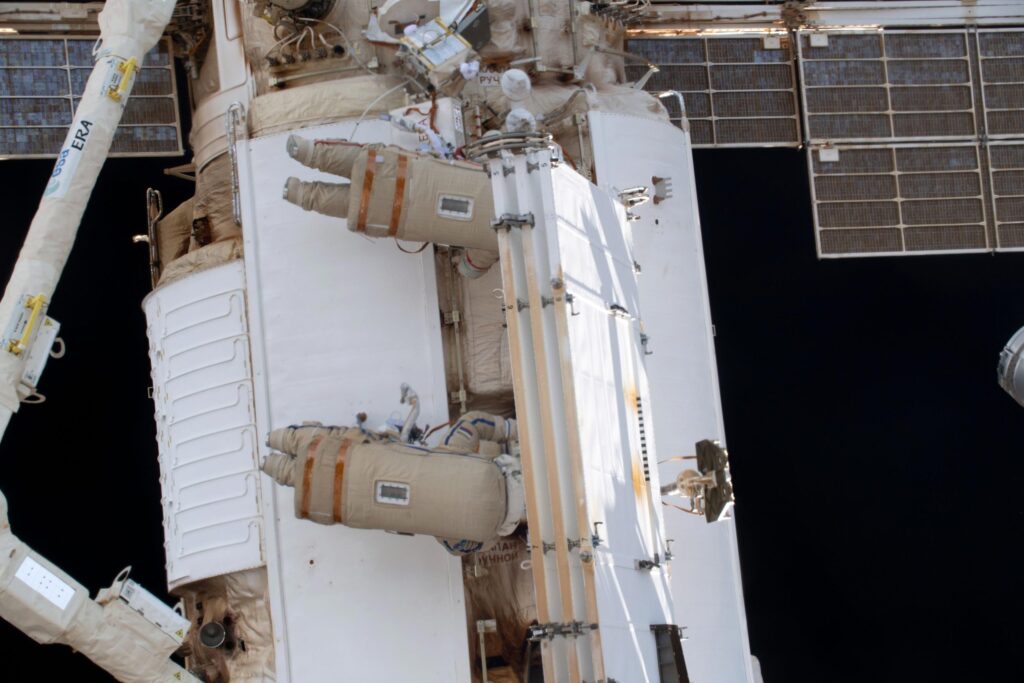
Botany and physics topped the research schedule as spacewalk cleanup duties continued aboard the International Space Station on Friday. The Expedition 69 crew also focused on life support maintenance as a U.S. cargo craft fired it engines to boost the orbital outpost.
Sustaining crews independently of cargo missions and taking advantage of microgravity for better manufacturing techniques are key targets for NASA’s and its international partners research programs. Friday’s science specifically looked at growing crops in space and advancing manufacturing techniques.
NASA Flight Engineer Frank Rubio set up seed bags for the Plant Habitat-03B study to understand how characteristics of plants grown in space change from one generation to the next. Results may inform ways to grow repeated generations of space crops to support future crewed missions. UAE (United Araba Emirates) astronaut Sultan Alneyadi worked in the Microgravity Science Glovebox servicing samples to learn how to manufacture superior graphene aerogel in microgravity. The SUBSA-μgGA physics study seeks to benefit Earth and space industries for better power storage, environmental protection, and chemical sensing.
The duo also assisted NASA Flight Engineer Woody Hoburg who worked throughout Friday swapping life support gear in the Tranquility module. A failed heat exchanger was removed and a new one was installed then connected to new low temperature loop hoses. NASA Flight Engineer Stephen Bowen aided his crewmates on Friday photographing Alneyadi’s research work and helping Hoburg during his life support maintenance. Bowen later removed sensors that measured his blood pressure and downloaded the data to doctors on the ground.
Cosmonauts Sergey Prokopyev and Dmitri Petelin continued cleaning their spacesuits and stowing tools and accessories following Wednesday’s spacewalk to install orbital debris shield and relocate a portable workstation. Roscosmos Flight Engineer Andrey Fedyaev assisted with the spacewalk cleanup work finalizing operations with the European robotic arm and stowing medical kits on Friday.
The Northrop Grumman Cygnus cargo spacecraft’s delta velocity thruster fired at 10:35 a.m. EDT Friday for 22 minutes, 48 seconds in a reboost of the International Space Station. The planned maneuver was designed to further refine the phasing for the Roscosmos Progress 85 cargo spacecraft launch on Tuesday, Aug. 22, from the Baikonur Cosmodrome in Kazakhstan, and its docking to the station Thursday, Aug. 24. It was one of two scheduled reboosts to target the proper trajectory for the Roscosmos Soyuz MS-24 launch and two-orbit rendezvous to the orbiting complex on Sept. 15, as well as the Soyuz MS-23 undocking and landing on Sept. 27.
The reboost also continued the certification of the use of Cygnus as a second spacecraft currently capable of conducting such a maneuver. The Cygnus reboost increased the station’s altitude by 3/10 of a mile at apogee and 2.8 miles at perigee and put the space station in an orbit of 262.5 x 257.6 statute miles.
Crew members who will soon fly aboard NASA’s SpaceX Crew-7 mission will enter quarantine Friday in one of the major milestones before they head to the launch site in Florida to start their mission to the International Space Station. The company’s Falcon 9 rocket is targeted to launch Crew-7 no earlier than 3:49 a.m. EDT on Friday, Aug. 25 from Launch Complex 39A at Kennedy.
Learn more about station activities by following the space station blog, @space_station and @ISS_Research on Twitter, as well as the ISS Facebook and ISS Instagram accounts.
Get weekly video highlights at: https://roundupreads.jsc.nasa.gov/videoupdate/
Get the latest from NASA delivered every week. Subscribe here: www.nasa.gov/subscribe




